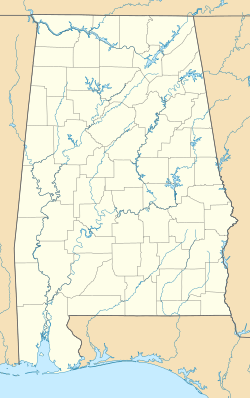Everhope Plantation facts for kids
|
Captain Nathan Carpenter House
|
|

Everhope in 2003
|
|
| Nearest city | Eutaw, Alabama |
|---|---|
| Built | 1853 |
| Architect | Anthony, David Rinehart |
| Architectural style | Greek Revival |
| NRHP reference No. | 99000793 |
Quick facts for kids Significant dates |
|
| Added to NRHP | July 23, 1999 |
Everhope Plantation is a beautiful old house near Eutaw, Alabama. It's also been known as the Captain Nathan Carpenter House and Twin Oaks Plantation. This historic plantation house was finished in 1853. It was built for Nathan Mullin Carpenter. Today, it is listed on the National Register of Historic Places. It is also on the Alabama Register of Landmarks and Heritage. This is because of its special design and important history.
Contents
History of Everhope Plantation
The Carpenter Family and Building the House
Nathan Mullin Carpenter's family moved to Greene County, Alabama in the early 1820s. They came from Franklin County, North Carolina. Nathan was born on December 22, 1826. He served in the Mexican–American War with a group called the Eutaw Rangers.
Nathan Carpenter married Catherine Cockrell in 1848. Sadly, she passed away in 1849. He married again in 1851 to Marjorie Pippen.
In 1852, Nathan and Marjorie Carpenter bought a large piece of land. It was about 667 acres (2.7 square kilometers). The main house was built between 1852 and 1853. A local builder named David Rinehart Anthony constructed it. His own house, built later in Eutaw, looks very similar. The Carpenter house also looked almost exactly like Pippen Place. This was a house built earlier by Marjorie's family. Nathan and Marjorie raised eight children in their new home. Five were born before the American Civil War and three after.
The Civil War Years
In 1862, Nathan Carpenter formed a group of soldiers. They were called the Confederate Rangers. He gathered them on the lawn in front of the house. Nathan was chosen as their captain. This group became Company B of the 36th Regiment Alabama Infantry.
Captain Carpenter's company fought in several important battles. These included Chattanooga, Chickamauga, Nashville, and the Atlanta Campaign. Nathan Carpenter passed away on May 5, 1907. Marjorie followed him on February 14, 1911.
New Owners and Restoration
The house was inherited by the Carpenters' daughter, Fannie. She never married. After her death in 1944, her nephew, Clifford S. Boyce, received the house. Clifford and his wife, Leah Graves, lived there until he died in 1974.
The house then sat empty for a few years. In 1977, the Dr. George E. Rudd family bought it. On December 21, 1977, the house was added to the Alabama Register of Landmarks and Heritage. Even then, the house did not have running water or bathrooms. The Rudd family used it only for weekends and holidays. Because they weren't there all the time, the house sometimes suffered from vandalism.
In 1994, Charles and Jan Bullock bought the Carpenter house and the land around it. They renamed the place Twin Oaks Plantation. The Bullocks started a big project to fix up the house. They also added modern comforts. In 1999, the house was added to the National Register of Historic Places. This happened while the Bullocks owned it.
David and Pam Harmon bought the house in 2005. The "twin oaks" that gave the plantation its name died soon after. So, the Harmons decided to rename the plantation Everhope. They continued to restore and care for the historic house. In 2012, Barden Smedberg bought Everhope. He opened it for tours, special events, and as a place for people to stay.
Architecture of Everhope
The Everhope house is built in the Greek Revival style. It is a two-story house made of wood. It has a roof that slopes down on two sides. The house's base and chimneys are made of brick.
The front of the house has a large, two-story porch. This porch is supported by four tall, eight-sided columns. The porch stretches across the entire front of the house. It covers all five sections of the front wall. There are double doors in the middle of each floor. These doors have narrow windows on the sides. A balcony sticks out from the second floor.
See also
 In Spanish: Everhope para niños
In Spanish: Everhope para niños



